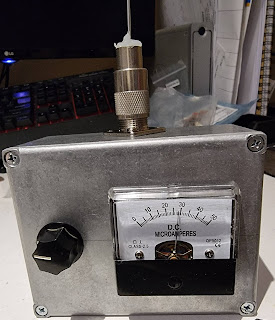A No-Power Field Strength Meter
Before you scoff, this meter does work, and it works well. Yet it has no battery, no amplifiers, transistors, valves, or even magical elves. There are just 4 diodes and a capacitor inside the box, and if you have basic hand tools, should be able to make one in about an hour.
The circuit is shown in figure 1, and it’s derived from my old RF Design textbook from the early 1980s. A simple antenna is connected to the SO-239 connector. A pair of diodes (D1 & D2 rectify the incoming voltage which charges C1. The variable resistor, VR1 acts as a sensitivity control to allow you to take relative measurements. Diodes D3 and D4 protect the meter from overloads.
Construction
There is no PCB or even board required. D1 and D2 are connected directly to the SO-239. C1 is soldered to the pins of VR1, while D3 and D4 are connected directly across the meter terminals. To avoid short circuits, I covered D1 in heat shrink. Also make sure all ground connections go back to a single point.
The antenna is very simple to construct. I used a piece of welding wire and soldered one end to the pin of a PL-239. To prevent short circuits, I filled the body of the plug with hot-melt glue. This way I can always recycle the plug if need be.
How do I use it?
Using the FSM is simplicity itself. Place it close to the antenna in question (1 -2m is a good starting point) and transmit a carrier. (Of course, you checked the frequency was clear, right?). Now adjust the pot to get ½ scale on the meter. Now you have a baseline for comparison work.
Other things to note
Component values are not critical. You could replace D1 and D2 with germanium diodes to get a little more sensitivity, but I don’t think this will be much benefit. The value of the pot could be changed if all the adjustment seems to be at one end of its travel. I found experimentally that 10K was about right for my equipment.
Also, you may want to put a little piece of bright coloured heat shrink on the end of the antenna to stop poking yourself in the eye with it.





Comments
Post a Comment